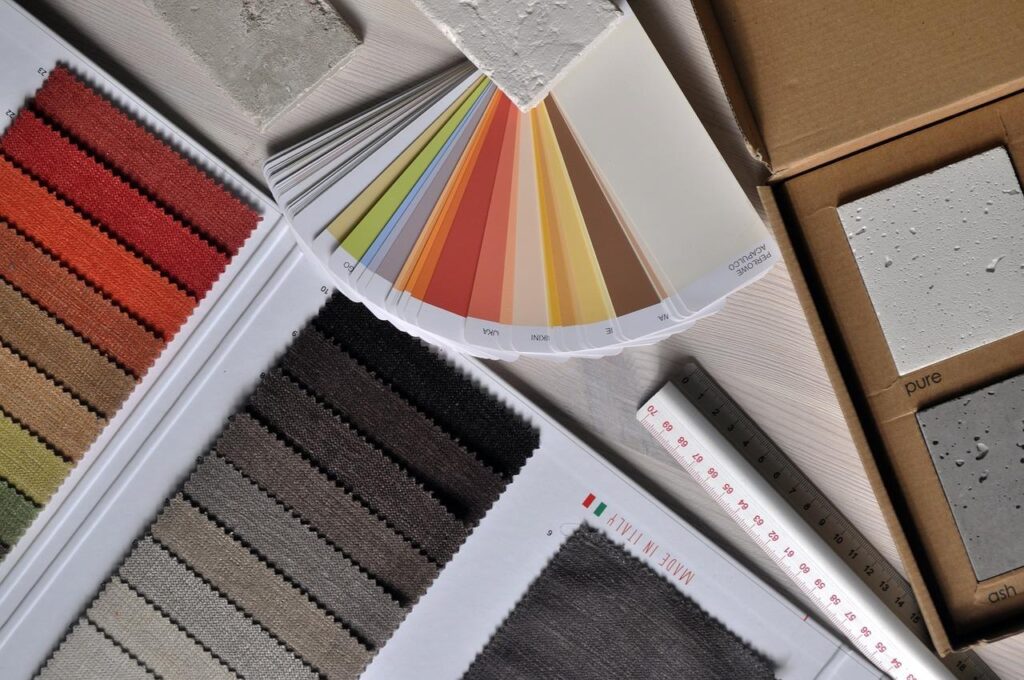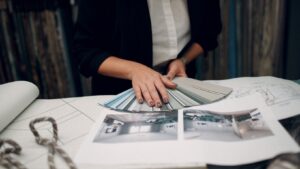
Decorating and designing a home can be exciting, but with so many options for paint colors, furniture styles, textiles, and accessories, it’s easy to feel overwhelmed. Using a mood board is a great way to pull together a cohesive home design centered around a specific style or theme.
What is a Mood Board?
A mood board is a collection of images, fabric swatches, color samples, and other materials that represent a particular style or mood. It provides visual inspiration and helps communicate your design vision. Mood boards are commonly used by interior designers and can be created digitally or by hand with physical materials.
To create a mood board, think about the overall style or theme you want for your home. This could be modern, traditional, coastal, mid-century modern, etc. Gather images that represent that style and evoke the look and feel you want. Arrange them together on a board, canvas, or digitally. Your mood board provides a central point of reference to guide all your design choices.
Select a Theme for Your Home
Picking a theme is an important first step when using a mood board to design your home. The theme helps tie all the elements together into a cohesive look. Here are some popular home design themes to consider:
Modern
This style is characterized by clean lines, sleek surfaces, open floor plans, and an abundance of natural light. Colors tend toward neutral palettes of white, black, gray, and wood tones. Key pieces include streamlined furniture and geometric patterns. Accessories are minimal.
Farmhouse
The farmhouse look features distressed woods, galvanized metal, and vintage-inspired fabrics like cotton, burlap, and linen. White painted walls and cabinets are common. Accents like mason jars, floral prints, and distressed rugs help achieve a rustic chic vibe.
Contemporary
Contemporary design focuses on a sleek, polished aesthetic using modern shapes and open layouts. Neutral, muted color palettes are punctuated with bold colorful accents. Common materials include leather, glass, metal, and high-gloss lacquered finishes.
Coastal
To evoke relaxed seaside living, coastal design incorporates textured fabrics like linen, nubby woods, rattan, and rope accents. Light airy colors like sea glass blue-green, sand, and coral work well. Nautical elements like ships’ wheels, maps, and netting details complete the look.
Create Your Mood Board
Once you settle on a theme, begin curating your mood board. Search for inspirational images online or in decorating magazines. Focus on gathering:
- Color schemes and patterns
- Furniture styles and key pieces
- Flooring and wall décor
- Fabric and textile options
- Lighting fixtures
- Accessory ideas like art, pillows, throws, area rugs
Arrange all the images and materials together on a board either physically or digitally through a site or app. Let your theme and overall vision guide the edit. Avoid cluttering the mood board. Include 15-30 inspirational photos or samples.

Make sure to include pinpoint details like paint swatches for your exact color scheme. Download digital images so all your ideas are in one place for reference. Use your completed mood board as a guide for all design, décor, and remodeling decisions.
Use Your Mood Board for Inspiration
With your themed mood board complete, reference it often as you design your home room-by-room. Rely on it when making important décor decisions like:
Paint Colors and Wallpaper
Hold paint chips and wallpaper samples up to your board to see if they fit your vision. Matching new colors directly to your mood board creates cohesion.
Furniture and Decor Purchases
Before buying any new furniture or accent pieces, check them against your mood board’s style. This helps prevent impulse purchases that don’t align with your theme.
Flooring
Hardwood, tile, and area rug options should coordinate with your color palette and style. Use your mood board to comparison shop for floors that work with your design.
Fabrics and Textiles
Choose new bedding, pillows, curtains, and upholstery that reflects the fabrics on your mood board. Consistency is key for a pulled-together look.
Lighting Fixtures
Your lighting choices like pendants, chandeliers, sconces, and table lamps should work with your theme.

Use your mood board as a reference to find options that enhance your design vision.
Evolve Your Design Over Time
As you decorate your home room-by-room, your mood board will act as an anchor for your design theme. But don’t feel locked into every detail. Let your style evolve naturally over time. Update your mood board periodically, removing outdated images and adding new favorites. Use it as a loose inspiration guide that captures the overall feel you want.
With a well-crafted mood board to set the direction, you can confidently design a cohesive home tailored to your theme and style. Let your creativity shine by displaying pieces you love that tell a story and reflect your personality. The final result will be a space with you at the center – your dream home brought to life.








